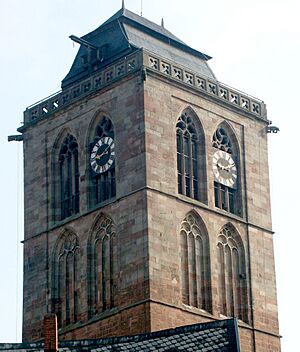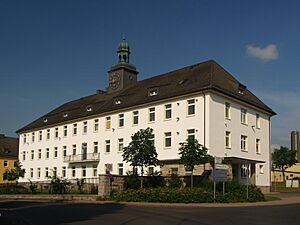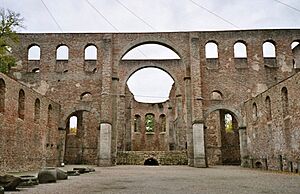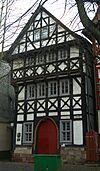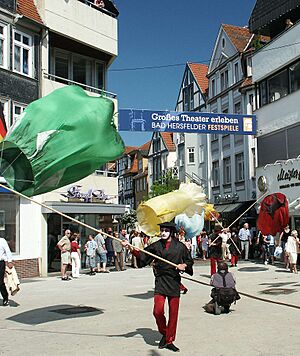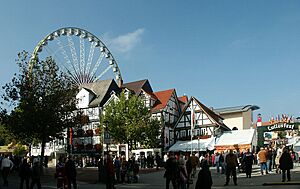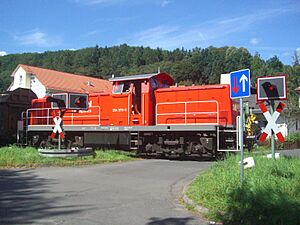Bad Hersfeld facts for kids
Quick facts for kids
Bad Hersfeld
|
||
|---|---|---|
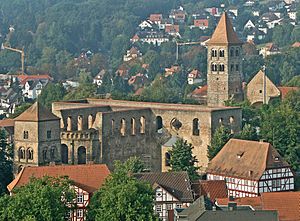
View of the monastery ruins from the tower of the town church
|
||
|
||
| Country | Germany | |
| State | Hesse | |
| Admin. region | Kassel | |
| District | Hersfeld-Rotenburg | |
| Elevation | 212 m (696 ft) | |
| Population
(2022-12-31)
|
||
| • Total | 30,652 | |
| Time zone | CET/CEST (UTC+1/+2) | |
| Postal codes |
36251
|
|
| Dialling codes | 06621 | |
| Vehicle registration | HEF | |
| Website | www.bad-hersfeld.de | |
Bad Hersfeld is a special town in Hesse, Germany. It's known as a festival and spa town. The word Bad means "spa" in German, showing it's a place for health and relaxation. The town is located about 50 km southeast of Kassel.
Bad Hersfeld is famous across Germany for its Bad Hersfelder Festspiele (festival). This big event has happened every year since 1951 at the old monastery ruins. These ruins are said to be the largest Romanesque church ruins in all of Europe!
In 1967, the town also hosted the seventh Hessentag, a big state festival.
Contents
Exploring Bad Hersfeld's Location
Where is Bad Hersfeld?
The town sits in a basin where the Fulda and Haune rivers meet. The main part of town is on the left side of the Fulda. Other smaller rivers, like the Geisbach and Solz, also flow into the Fulda here.
Around Bad Hersfeld, you can see different mountain ranges. To the southwest are the Vogelsberg Mountains, to the northwest is the Knüll, and to the northeast is the Seulingswald.
The lowest point in town is 195 m above sea level, where the Solz river joins the Fulda. The highest point is the Laxberg, at 408 m above sea level.
Bad Hersfeld is considered part of both Northern and Eastern Hesse.
Nearby Cities and Special Roads
The closest big cities are Kassel (52 km north), Gießen (79 km southwest), Fulda (36 km south), and Eisenach (45 km east).
A special holiday road called the Deutsche Fachwerkstraße (German Timber Frame Road) passes through Bad Hersfeld. This road shows off many beautiful old timber-frame houses and buildings across Germany.
How the Town is Built
The Old Town of Bad Hersfeld is built on layers of gravel and pebbles. These were washed up by the Fulda and Geisbach rivers long ago. The town also has two natural mineral springs deep underground. These springs are why Bad Hersfeld is a spa town.
Town Size and Parts
Today, the main town of Bad Hersfeld stretches about 4.5 km from southwest to northeast and 3.5 km from northeast to southwest.
The Old Town, located in the Fulda valley, is shaped like an oval and covers about 40 hectares. It's about 960 m long and 570 m wide. You can still see its old shape because a ring road now follows where the town moat used to be.
Besides the main town, Bad Hersfeld also includes several smaller villages. These are Allmershausen, Asbach, Beiershausen, Eichhof, Heenes, Hohe Luft, Johannesberg, Kathus, Kohlhausen, Petersberg, and Sorga.
Neighboring Towns
The towns bordering Bad Hersfeld are Ludwigsau (north), Friedewald (northeast), Schenklengsfeld (east), Hauneck (southeast), Niederaula (south), Kirchheim (southwest), and Neuenstein (west).
Bad Hersfeld's Weather
Bad Hersfeld is in a valley, which protects it from harsh weather. This means it has a fairly warm average yearly temperature of 8.7 °C and not too much rain, with about 718.1 mm of precipitation each year. The town also gets a good amount of sunshine, around 1,385.4 hours annually.
On average, Bad Hersfeld has 34 "summer days" (25 °C or hotter), 86 "frost days" (below 0 °C), and 22 "ice days" (never rising above 0 °C).
| Climate data for Bad Hersfeld (1991–2020 normals) | |||||||||||||
|---|---|---|---|---|---|---|---|---|---|---|---|---|---|
| Month | Jan | Feb | Mar | Apr | May | Jun | Jul | Aug | Sep | Oct | Nov | Dec | Year |
| Mean daily maximum °C (°F) | 3.4 (38.1) |
5.0 (41.0) |
9.5 (49.1) |
14.8 (58.6) |
18.8 (65.8) |
22.1 (71.8) |
24.4 (75.9) |
24.1 (75.4) |
19.3 (66.7) |
13.6 (56.5) |
7.6 (45.7) |
4.1 (39.4) |
13.9 (57.0) |
| Daily mean °C (°F) | 0.8 (33.4) |
1.4 (34.5) |
4.7 (40.5) |
9.0 (48.2) |
13.0 (55.4) |
16.3 (61.3) |
18.2 (64.8) |
17.8 (64.0) |
13.5 (56.3) |
9.1 (48.4) |
4.7 (40.5) |
1.8 (35.2) |
9.2 (48.6) |
| Mean daily minimum °C (°F) | −1.9 (28.6) |
−1.9 (28.6) |
0.4 (32.7) |
3.2 (37.8) |
7.0 (44.6) |
10.4 (50.7) |
12.4 (54.3) |
12.0 (53.6) |
8.6 (47.5) |
5.3 (41.5) |
1.9 (35.4) |
−0.8 (30.6) |
4.7 (40.5) |
| Average precipitation mm (inches) | 51.3 (2.02) |
39.3 (1.55) |
46.0 (1.81) |
40.6 (1.60) |
66.9 (2.63) |
57.9 (2.28) |
83.3 (3.28) |
60.4 (2.38) |
50.1 (1.97) |
52.8 (2.08) |
52.3 (2.06) |
53.5 (2.11) |
654.4 (25.76) |
| Average precipitation days (≥ 1.0 mm) | 17.9 | 15.8 | 15.8 | 12.7 | 14.2 | 13.7 | 14.9 | 13.7 | 13.1 | 15.8 | 17.1 | 18.9 | 183.7 |
| Average snowy days (≥ 1.0 cm) | 8.4 | 7.3 | 2.6 | 0.2 | 0 | 0 | 0 | 0 | 0 | 0 | 1.6 | 4.7 | 24.8 |
| Average relative humidity (%) | 85.9 | 82.4 | 77.1 | 70.6 | 72.3 | 72.6 | 72.1 | 73.4 | 80.1 | 85.7 | 88.7 | 88.5 | 79.1 |
| Mean monthly sunshine hours | 44.1 | 67.8 | 115.4 | 172.0 | 197.6 | 203.3 | 213.2 | 197.6 | 142.1 | 88.7 | 39.2 | 31.5 | 1,511.5 |
| Source: World Meteorological Organization | |||||||||||||
A Look at Bad Hersfeld's Past

The story of Bad Hersfeld began with a monk named Saint Sturm. He started a monastery here, which was later re-established by Lullus in 769. Both were students of the famous missionary bishop Boniface.
Lullus's remains were moved in 852, and at that time, he was made a saint. Since then, the Lullusfest has been celebrated every year around October 16th. It's the oldest folk festival in Germany!
Archaeological digs show that people lived in this area much earlier. Traces of settlements go back to the New Stone Age (around 2000 BC). A Bronze Age grave from about 1200 BC has also been found.
Hersfeld was first mentioned as a market in 1142 and as a town in 1170. The monastery was very important in the Holy Roman Empire during this time. Over the centuries, the monastery's power decreased.
In 1521, Martin Luther visited the monastery and gave a sermon. Soon after, the town became mostly Protestant.
In 1439, a large fire destroyed much of the town. The oldest timber-frame house still standing, the Küsterhaus, was built in 1452.
During the Seven Years' War in 1761, the French army burned down the monastery church and buildings. They did this to destroy their supplies as they retreated. This sadly ruined one of Germany's largest churches. In 1807, the town was almost completely destroyed by Napoleon's troops. However, a brave officer named Johann Baptist Lingg von Linggenfeld saved most of it by only setting fire to four separate buildings, following orders "literally."
In 1821, Hersfeld became the main town of its district. It was connected to the railway network in 1866 and got an Autobahn link in 1938. The town began to develop as a spa town when the Lullusbrunnen (spring) was found in 1904.
During the Cold War, Bad Hersfeld was a very important location. It was near the border between East and West Germany. American soldiers were stationed here from 1948 to 1993 at McPheeters Barracks. They were the first line of defense in case of an attack from the east.
In 1949, the town officially became "Bad" Hersfeld, recognizing its status as a spa town. In 1963, it became a Hessian State Spa.
In May 1983, many people in the town protested against a gathering of certain historical groups. The organizers of the Bad Hersfelder Festspiele were among those who supported the protest.
Religious Life
Bad Hersfeld has both Protestant and Catholic churches. There are also several other Christian communities and free churches, such as Baptists and Seventh Day Adventists. Other religious groups like the New Apostolic Church and Jehovah's Witnesses also have communities here.
Town Growth
Bad Hersfeld has grown over the years by adding nearby villages. In 1918, Kalkobes joined the town, and in 1928, Johannesberg was added. In 1972, many more villages became part of Bad Hersfeld. At the same time, the Hersfeld and Rotenburg districts merged, and Bad Hersfeld became the main town of the new Hersfeld-Rotenburg district.
How the Population Changed
In 1525, about 400 households lived in Bad Hersfeld. Before the Thirty Years' War in 1614, there were about 725 households, meaning 3,300 to 3,600 people. The population dropped sharply during the Thirty Years' War, as shown in the chart below.
After the war, the population grew slowly, sometimes falling due to wars, diseases, and famines. It only started to rise quickly in the mid-1800s as the town grew and industries like textile and machine building expanded. By 1913, it passed 10,000 people, and after Second World War, it reached 20,000. After the villages joined in 1972, the population was around 27,000, and by the mid-1990s, it reached 30,000.
Fun Things to See and Do
Since 1962, Bad Hersfeld has given out the Hersfeld-Preis award to actors at the festival. Another special award is the Ulenroder Kruzifix, a copy of an old bronze cross found near the town.
Theatre and Shows
Every summer, the famous Bad Hersfelder Festspiele (festival) takes place. Outside of festival season, you can watch plays and shows at the Stadthalle, which is a big event venue.
Museums to Visit
- The Bad Hersfeld Town Museum is in the only part of the old monastery that is still standing. It tells the story of the town and the monastery, and also shows local crafts.
- The Konrad Duden Museum is next to the old monastery school. Konrad Duden was a principal here from 1876 to 1905. He was famous for creating the standard German dictionary.
- The Haus Mährisch Schönberg museum shows historical items from a German-speaking region that is now in the Czech Republic.
- Since 2006, there's been a small savings bank museum at the Sparkasse Bad Hersfeld-Rotenburg. It shows how banking has changed over time.
Famous Buildings
The Old Town has 216 buildings that are protected as historical monuments. On the west side, you'll find the monastery ruins. They are the biggest church ruins in Europe and are used for the Bad Hersfelder Festspiele. Inside the monastery area is the Katharinenturm (tower), which holds the Lullusglocke, Germany’s oldest dated bell (from 1038 AD). Parts of the old town wall, like the South Gate and the Halbschalenturm, are also still there.
The two Nordschulteiche (ponds) in the Leonhard Müller Complex are what's left of the old town moat. Here you can also see Saint Vitalis's Cross, which marks where townsmen fought off an attack in 1378. Other parts of the town's old defenses, like the Klausturm (a watchtower and prison) and the Pulverturm ("Powder Tower"), are in the eastern part of the Old Town.
The Elisabeth-Hospital, founded in 1239, has a beautiful Gothic chapel. Other old monastery buildings include the Schloss Eichhof and the ruins of the Bruderhaus. These are about 3 km from the Old Town and can be reached from the spa park.
In the center of the Old Town is the Gothic Stadtkirche ("Town Church"). Its 14th-century tower is a symbol of the town. Around the church square, there are many timber-frame buildings. The oldest one is the Küsterhaus (sexton's house), built in 1452. Next to it is the Town Hall, built around 1371 in the Gothic style and later updated in the Weser Renaissance style. You'll find more timber-frame houses in the pedestrian precinct, especially the beautifully decorated Zimmermannshaus.
On Linggplatz, there's a statue that reminds everyone of Lieutenant Colonel Johann Baptist Lingg von Linggenfeld. He saved the town from being burned down in 1807. Nearby is the marketplace with old patrician houses and the former mint. On the Neumarkt ("New Market"), you can see the Linggklause (Lieutenant Colonel Lingg's home) and the Konrad Duden Museum.
Parks and Green Spaces
The largest park in town is the Kurpark (spa park), which is about 6.5 hectares. It has the Kurhaus (spa house), a pump room, and a spring pavilion. Close to the Old Town is the Leonardt-Müller-Anlage park, which runs along the old town wall and has two ponds. The monastery area also has a park that was expanded in 2006 with a garden.
Other green areas include the 15-hectare Fuldapark with its Fuldasee (lake) and the Carl-Strauß-Anlage.
Sports for Everyone
- Football: Many villages have football clubs, and SVA Bad Hersfeld is a well-known club.
- Team Sports: The Turnverein Hersfeld 1848 e. V. (gymnastic club) offers team handball, volleyball, and basketball.
- Handball: The SG Hessen Hersfeld women's team played in Germany's top Handball-Bundesliga for several seasons.
- Water Sports: Three clubs (Hersfelder Kanu-Club 1924 e. V., Kanu-Wanderer Hersfeld 1986 e. V., and Hersfelder Ruderverein 1977 e. V.) offer rowing and canoeing on the Fulda river.
- Shooting: The Hersfelder Schützengilde ("Marksmen’s Guild") 1252 e. V. is one of Germany's oldest active clubs.
- Air Sports: The Luftsportverein Bad Hersfeld e. V. has a glider facility nearby.
Fun Events All Year Round
- Bad Hersfelder Festspiele: This famous festival, including opera and concerts, happens every year from June to August in the monastery ruins.
- Music Events:
* The Bad Hersfeld Bach Days (around Easter) feature classical music. * The Live-Jazz-Festival (first weekend in June) brings jazz stars to the Old Town. * The StadtJugendNacht ("Town Youth Night") is in September. * The Metalfest (late every year) features hard rock and metal bands.
- Lullusfest: Germany's oldest folk festival takes place every year in the week of October 16th.
- Other Festivals: There's a shooting festival and the Tagebergfest (an outdoor forest festival).
- Sporting Events: The Sauer Lollslauf is a marathon run during Lullusfest. There's also an international motorcycle race on a 500 m track.
- Markets: Most markets are held on Linggplatz. There's a weekly market twice a week, a flea market from April to October, and yearly markets like the Easter Market and Autumn Market.
Economy and Town Services
Since German reunification, Bad Hersfeld is in the middle of Germany. Its location near major Autobahns (A 4 and A 7) has made it a hub for logistics companies.
Bad Hersfeld has a large volunteer fire brigade that sometimes helps other towns in Germany.
Getting Around
Roads
Major north-south Autobahns, the A 5 and A 7, meet the east-west A 4 near Bad Hersfeld.
Important national roads, Bundesstraße 27 and Bundesstraße 62, also meet in Bad Hersfeld. Bundesstraße 324 connects to the A 7.
Trains
Bad Hersfeld is on the train line connecting Kassel, Bebra, and Fulda. You can catch an ICE train every two hours to cities like Frankfurt am Main, Eisenach, Erfurt, Weimar, Leipzig, and Berlin/Dresden. Regional trains also run to Kassel and Göttingen.
Local Buses
Buses in Bad Hersfeld are part of the Nordhessischer Verkehrsverbund (North Hesse Transport Association). There are nine town bus routes and four routes that connect to other towns.
Air Travel
The Flugplatz Johannesberg is a small airfield near the town. It has a paved runway about 671 m long. This airfield was built by the United States Army in the 1950s and was used by them until 1993. Now, a local flying club uses it.
Businesses in Town
Bad Hersfeld has a long history in textile manufacturing. Performance Fibers, which makes strong polyester fibers, is one such company. Other long-standing family businesses include Lorenz Mohr GmbH & Co. KG (mineral oil) and Kirchner Holding GmbH (building).
In electronics, you'll find EN ElectronicNetwork Hersfeld GmbH and Thales e-Transactions GmbH. For machine building, there are Grenzebach BSH GmbH, Linde Ladenbau GmbH & Co. KG, and TLT Turbo GmbH.
After German reunification, many logistics companies moved here, including amazon.de, Libri (a book wholesaler), and RS Components (which has its European hub here).
Hospitals are also a big part of the local economy. Bad Hersfeld has several hospitals and clinics, including Klinikum Bad Hersfeld and Krankenhaus St. Elisabeth Bad Hersfeld, plus various spa clinics for different health needs.
The biggest bank in town is the Sparkasse Bad Hersfeld-Rotenburg.
Music Scene
After the Festspiele, an opera festival is held in the monastery ruins. The Arbeitskreis für Musik e. V. also organizes the Bad Hersfelder Festspielkonzerte throughout the year. The Internationale Bachtage in Hessen und Thüringen features great choral works and chamber music every year during Holy Week and Easter.
The jazz festival, held on the first weekend in June, brings national and international jazz stars to the town. In autumn, the Cross Music Metalfest features hard rock and metal bands from around the world.
Local Media
The local daily newspaper is the Hersfelder Zeitung, which started in 1763. There are also free advertising papers like Kreisanzeiger and Klartext. Since 2008, FunRadio Hersfeld has been broadcasting from the town.
Public Places and Services
Bad Hersfeld has many public facilities. The Stadthalle is a venue for events. The Konrad-Duden-Stadtbibliothek (town library) opened in 1999 and has about 65,000 items.
For sports, there are two baths: Aqua Fit (for sports and families) and Kurbad Therme (a wellness bath). There's also the heated swimming pool Geistalbad. You can also find the Jahn-Park (sport and leisure center) and Nordic-Walking-Park.
Spa and Wellness
Bad Hersfeld has two mineral springs. The Lullusquelle was rediscovered in 1904, and the Vitalisbrunnen was found in 1949. The water from these springs is rich in Glauber's salt. You can even buy bottled mineral water from Naturquellen Bad Hersfeld.
The spa treatments involve drinking and bathing in this mineral water. They are used to help with liver, stomach, intestinal, and metabolic issues, as well as muscle and joint problems.
Youth Activities
Besides sports clubs, young people can meet at the Jugendhaus Bad Hersfeld on Dippelstraße. It's a popular place for youth events.
Learning and Schools
Bad Hersfeld has three comprehensive schools: Gesamtschule Geistal, Gesamtschule Obersberg, and Konrad-Duden-Schule. The Konrad-Duden-Schule was founded in 1570 as a monastery school. Konrad Duden, who created the famous German dictionary, was its principal from 1876 to 1905.
The Modellschule Obersberg offers a Gymnasium-style upper level for older students.
There are also six primary schools: Ernst-von-Harnack-Schule, Grundschule An der Sommerseite, Grundschule Sorga, Kolibri-Grundschule, Linggschule, and Wilhelm-Neuhaus-Schule. A special school, Friedrich-Fröbel-Schule, is also in town.
For vocational training, there are three schools: Berufliche Schulen des Landkreises Hersfeld-Rotenburg, Berufsbildungszentrum Metall, and Bildungszentrum für Handel und Dienstleistung.
Further education is available at the Studienakademie für Logistik, an evening school for adults, and the district folk high school.
Partner Towns
Bad Hersfeld has special connections with these towns:
 Bad Salzungen, Germany (since 1990)
Bad Salzungen, Germany (since 1990) L'Haÿ-les-Roses, France (since 1994)
L'Haÿ-les-Roses, France (since 1994) Šumperk, Czech Republic (since 1979)
Šumperk, Czech Republic (since 1979)
Famous People from Bad Hersfeld
Many notable people have lived or worked in Bad Hersfeld:
- Lullus (about 710–786), the first abbot of the Hersfeld monastery.
- Lampert von Hersfeld (c. 1028 – c. 1085), a historian and abbot.
- Johann Baptist Lingg von Linggenfeld (1765–1842), a lieutenant general who saved the town from burning.
- Konrad Duden (1829–1911), a famous German dictionary creator and school principal here.
- Benno Schilde (1849–1911), an inventor and founder of a machine building company.
- Max Becker (1888–1960), a German politician who helped start the Bad Hersfelder Festspiele.
- Johannes Klein (1897–1976), founder and first artistic director of the Bad Hersfelder Festspiele.
- Konrad Zuse (1910–1995), a German computer pioneer who moved his company to Bad Hersfeld.
- Uwe Bein (born 1960), a professional footballer and world champion in 1990.
- Dirk Müller (born 1973), a German bicycle racer and 2006 German Road Champion.
- Sheila Gaff (born 1989), an international Mixed Martial Artist.
- Shkodran Mustafi (born 1992), a professional footballer and world champion in 2014.
|
See also
 In Spanish: Bad Hersfeld para niños
In Spanish: Bad Hersfeld para niños




